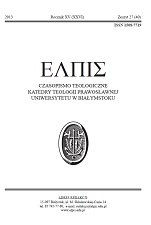Wpływy bizantyjsko-bałkańskie na ziemiach polskich na przykładzie Kodeksu Supraskiego
Byzantine and Balkan influences on Polish lands on the ex ample of the Codex Suprasliensis
Author(s): Andrzej BorkowskiSubject(s): Christian Theology and Religion
Published by: Wydawnictwo Uniwersytetu w Białymstoku
Keywords: Codex Suprasliensis; cyrylic manuscript; monastery of Supraśl; Michał Bobrowski; the Byzantine Commonwealt;; the Balkans; Slavia Orthodoxa
Summary/Abstract: The Codex Suprasliensis (called also the Retkov Sbornik), a Cyrillic manuscript copied in the late 10th century, is the largest extant Bulgarian manuscript from the Preslav literary school. Codex Suprasliensis contains 24 vitae of Christian saints for March and 23 homilies for the movable cycle of the church year. The Codex Suprasliensis is written on parchment and shows careful writing and craftsmanship. It was discovered in 1823 in the Monastery of Supraśl by Canon Michał Bobrowski. He sent it to the Slovenian scholar Bartholomaeus (Jernej) Kopitar for study. After Kopitar’s death the first 118 folios were preserved in the University Library in Ljubljana, where they are still kept. The following 16 leaves were purchased by A. F. Byčkov in 1856 and are now located in the Russian National Library in St. Petersburg. There maining 151 leaves found themselves in the collection of the Counts Zamoyski; this so-called Warsaw part disappeared during World War II and was long considered lost until it reemerged in the USA and was returned to Poland in 1968. It is now located in the National Library in Warsaw. The Codex Suprasliensis has been listed in the UNESCO’s Memory of the World Register since 2007. The Codex Suprasliensis is very importand by all who are interested in the history of Bulgaria, the Byzantine Commonwealth, the Balkans and Slavia Orthodoxa.
Journal: Elpis
- Issue Year: 2013
- Issue No: 15
- Page Range: 63-68
- Page Count: 6
- Language: Polish

